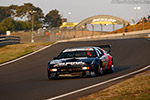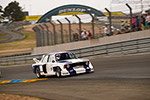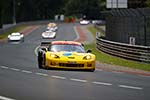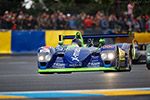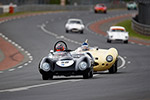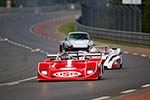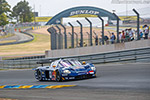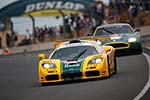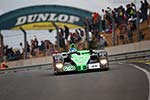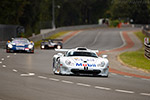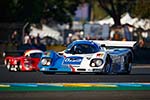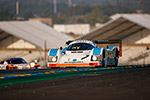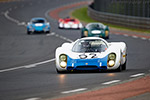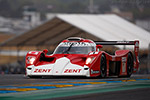Le Mans Centenary

Traditionally a biennial event on even years, a special Le Mans Classic was staged in 2023 as part of the 24 Hours of Le Mans centenary celebrations. First held in 1923, the 24 Hours of Le Mans is considered the greatest endurance race of all with a very rich history to match. This is celebrated every two years with the Le Mans Classic but this year, the dial was turned to eleven. A sell-out crowd of 235,000 was treated to three days of non-stop action with 24 races by ten different race groups and 900 race cars, covering almost all hundred years of the 24 Hours of Le Mans.
A true 24-hour race, the Le Mans Classic has always featured three 43-minute races for each of the main grids running from 4 pm on Saturday through the night to 4 pm on Sunday. Split by age, these six fields spanned a period from 1923 through to 1981. For the first time, two of the support races were part of the rotation with additional races for the Group C and even more modern Endurance Racing Legends groups scheduled for Sunday morning and afternoon respectively. Also out on track in the build-up to the main event were races for pre-War Bentleys and air-cooled Porsches.
We were on track from the start to finish and through the night with this
210-shot gallery as the spectacular result.
Winner's parade

As part of the centenary celebrations, the spectators were also treated to a parade of a selection of significant Le Mans cars that were on display in the official Museum. These included a remarkable amount of winners, including the two-time winning TWR Porsche WSC95 and Ferrari 275 P but also the iconic Cadillac Series 61 'Le Monstre'. Quite a few cars were also reunited with their original drivers, so we saw Henri Pescarolo behind the wheel of his winning Matra MS670B and Stefan Johansson piloting the TWR Porsche. There were also winning cars competing in the main event; the Alfa Romeo 8C 2300 from 1934 and the Ford GT40 Mk2 that secured the highly coveted trophy for the 'Blue Oval' for the first time, in 1966. As part of the Group C race was the Porsche 962C that scored the outright Le Mans win in 1986. Among the many other significant cars entered was the Bentley that competed in the first edition and sparked a flame with the British company that would result in five wins between 1924 and 1930.
The six plateaus

After a day's worth of build-up the earliest cars,
Plateau 1 lined up for a traditional Le Mans start. The signal for the drivers to start running across the track was given by none other than tennis legend Rafael Nadal. All three races for the first grid were dominated by the Talbot AV 105 shared by Gareth Burnett and Michael Birch. A sister car placed second, while best of the rest was a BMW 328. The earliest post-War cars were grouped in
Plateau 2. The races turned out to be dominated by a pair of XK engines. The winner in all three was the six-cylinder engined Jaguar D-Type of Niklas and Lucas Halusa, beating the similarly powered Cooper T38 of Fred Wakeman and Patrick Blakeney-Edwards. The second half of the 1950s was covered by the third grid. The three races for this field had different winners with Andy Wallace winning two heats and the overall honours with his long-nose Jaguar D-Type, while Emanuele Pirro steered the Lister Costin Jaguar he shared with Hans Hugenholtz to victory in the third race.

Among the most hotly disputed of the six grids was
Plateau 4, which included early Ford GT40s. There were several very quick examples entered, including last year's winning GT40 of Diogo Ferrao and the example shared by Ford CEO Jim Farley and Eric van de Poele. Pole position was for the Christian Gläsel and Seb Perez GT40 but in the end it was Ferraro who came out on top after three races for the second year running, ahead of Emile Breittmayer and Shaun Lynn in other GT40s. While there were also GT40s in
Plateau 5, it was the Lola T70 that dominated this field. Oliver Bryant was very fast in his ex-Ulf Norinder T70 Mk3B but he was unlucky on several occasions. Instead, it was the example shared by father and son, David and Oliver Hart that came out on top on Sunday afternoon.
Plateau 6 was for the most modern cars that competed in the main event. Three-litre engined prototypes were at the sharp end of the field with pole-man Maxime Guenat in this Lola T286 the clear favourite. He dominated the races as the other DFV engined cars faded away. It was his second win of the weekend, after also securing victory in the Porsche race with his 935.
Endurance Racing Legends

Perhaps the most impressive field of the weekend was for the Endurance Racing Legends. Significantly oversubscribed, the race for 1990s and early 2010s GTs and prototypes in the end featured 75 entries. It was not just a numbers game as the list included a Toyota GT-One, two Bentley Speed 8s, an Audi R8, four Prodrive Ferrari 550 Maranellos, a McLaren F1 GTR and a whole range of Porsche 911s including a GT1 and several GT2s. The main race, on Saturday, was won by Emanuel Collard, who was reunited with the Pescarolo LMP1 car he raced in period. During qualifying, the car was driven by the 80-year old Henri Pescarolo himself. Collard also crossed the line first in the sprint race but was attributed a penalty for ignoring a slow zone, which elevated François Perrodo and his Toyota to the top spot on the podium. Third in both races was for father and son Hart with their Courage C60. An impressive fifth overall in the feature race was for Darren Turner, who was reunited with the Aston Martin DBR9 that he drove to fifth overall and first in the GT1 class back in 2007.
Final thoughts
The eleventh edition of the Le Mans Classic was more than a fitting finale of the Le Mans 24 Hours centenary celebrations. The action on and off the track was non-stop and there was something for everyone to enjoy. We were particularly impressed with some of the great drives from both the professional and the gentleman racers. All this and much more can be found in our
210-shot gallery.

 Traditionally a biennial event on even years, a special Le Mans Classic was staged in 2023 as part of the 24 Hours of Le Mans centenary celebrations. First held in 1923, the 24 Hours of Le Mans is considered the greatest endurance race of all with a very rich history to match. This is celebrated every two years with the Le Mans Classic but this year, the dial was turned to eleven. A sell-out crowd of 235,000 was treated to three days of non-stop action with 24 races by ten different race groups and 900 race cars, covering almost all hundred years of the 24 Hours of Le Mans.
Traditionally a biennial event on even years, a special Le Mans Classic was staged in 2023 as part of the 24 Hours of Le Mans centenary celebrations. First held in 1923, the 24 Hours of Le Mans is considered the greatest endurance race of all with a very rich history to match. This is celebrated every two years with the Le Mans Classic but this year, the dial was turned to eleven. A sell-out crowd of 235,000 was treated to three days of non-stop action with 24 races by ten different race groups and 900 race cars, covering almost all hundred years of the 24 Hours of Le Mans. As part of the centenary celebrations, the spectators were also treated to a parade of a selection of significant Le Mans cars that were on display in the official Museum. These included a remarkable amount of winners, including the two-time winning TWR Porsche WSC95 and Ferrari 275 P but also the iconic Cadillac Series 61 'Le Monstre'. Quite a few cars were also reunited with their original drivers, so we saw Henri Pescarolo behind the wheel of his winning Matra MS670B and Stefan Johansson piloting the TWR Porsche. There were also winning cars competing in the main event; the Alfa Romeo 8C 2300 from 1934 and the Ford GT40 Mk2 that secured the highly coveted trophy for the 'Blue Oval' for the first time, in 1966. As part of the Group C race was the Porsche 962C that scored the outright Le Mans win in 1986. Among the many other significant cars entered was the Bentley that competed in the first edition and sparked a flame with the British company that would result in five wins between 1924 and 1930.
As part of the centenary celebrations, the spectators were also treated to a parade of a selection of significant Le Mans cars that were on display in the official Museum. These included a remarkable amount of winners, including the two-time winning TWR Porsche WSC95 and Ferrari 275 P but also the iconic Cadillac Series 61 'Le Monstre'. Quite a few cars were also reunited with their original drivers, so we saw Henri Pescarolo behind the wheel of his winning Matra MS670B and Stefan Johansson piloting the TWR Porsche. There were also winning cars competing in the main event; the Alfa Romeo 8C 2300 from 1934 and the Ford GT40 Mk2 that secured the highly coveted trophy for the 'Blue Oval' for the first time, in 1966. As part of the Group C race was the Porsche 962C that scored the outright Le Mans win in 1986. Among the many other significant cars entered was the Bentley that competed in the first edition and sparked a flame with the British company that would result in five wins between 1924 and 1930. After a day's worth of build-up the earliest cars, Plateau 1 lined up for a traditional Le Mans start. The signal for the drivers to start running across the track was given by none other than tennis legend Rafael Nadal. All three races for the first grid were dominated by the Talbot AV 105 shared by Gareth Burnett and Michael Birch. A sister car placed second, while best of the rest was a BMW 328. The earliest post-War cars were grouped in Plateau 2. The races turned out to be dominated by a pair of XK engines. The winner in all three was the six-cylinder engined Jaguar D-Type of Niklas and Lucas Halusa, beating the similarly powered Cooper T38 of Fred Wakeman and Patrick Blakeney-Edwards. The second half of the 1950s was covered by the third grid. The three races for this field had different winners with Andy Wallace winning two heats and the overall honours with his long-nose Jaguar D-Type, while Emanuele Pirro steered the Lister Costin Jaguar he shared with Hans Hugenholtz to victory in the third race.
After a day's worth of build-up the earliest cars, Plateau 1 lined up for a traditional Le Mans start. The signal for the drivers to start running across the track was given by none other than tennis legend Rafael Nadal. All three races for the first grid were dominated by the Talbot AV 105 shared by Gareth Burnett and Michael Birch. A sister car placed second, while best of the rest was a BMW 328. The earliest post-War cars were grouped in Plateau 2. The races turned out to be dominated by a pair of XK engines. The winner in all three was the six-cylinder engined Jaguar D-Type of Niklas and Lucas Halusa, beating the similarly powered Cooper T38 of Fred Wakeman and Patrick Blakeney-Edwards. The second half of the 1950s was covered by the third grid. The three races for this field had different winners with Andy Wallace winning two heats and the overall honours with his long-nose Jaguar D-Type, while Emanuele Pirro steered the Lister Costin Jaguar he shared with Hans Hugenholtz to victory in the third race. Among the most hotly disputed of the six grids was Plateau 4, which included early Ford GT40s. There were several very quick examples entered, including last year's winning GT40 of Diogo Ferrao and the example shared by Ford CEO Jim Farley and Eric van de Poele. Pole position was for the Christian Gläsel and Seb Perez GT40 but in the end it was Ferraro who came out on top after three races for the second year running, ahead of Emile Breittmayer and Shaun Lynn in other GT40s. While there were also GT40s in Plateau 5, it was the Lola T70 that dominated this field. Oliver Bryant was very fast in his ex-Ulf Norinder T70 Mk3B but he was unlucky on several occasions. Instead, it was the example shared by father and son, David and Oliver Hart that came out on top on Sunday afternoon. Plateau 6 was for the most modern cars that competed in the main event. Three-litre engined prototypes were at the sharp end of the field with pole-man Maxime Guenat in this Lola T286 the clear favourite. He dominated the races as the other DFV engined cars faded away. It was his second win of the weekend, after also securing victory in the Porsche race with his 935.
Among the most hotly disputed of the six grids was Plateau 4, which included early Ford GT40s. There were several very quick examples entered, including last year's winning GT40 of Diogo Ferrao and the example shared by Ford CEO Jim Farley and Eric van de Poele. Pole position was for the Christian Gläsel and Seb Perez GT40 but in the end it was Ferraro who came out on top after three races for the second year running, ahead of Emile Breittmayer and Shaun Lynn in other GT40s. While there were also GT40s in Plateau 5, it was the Lola T70 that dominated this field. Oliver Bryant was very fast in his ex-Ulf Norinder T70 Mk3B but he was unlucky on several occasions. Instead, it was the example shared by father and son, David and Oliver Hart that came out on top on Sunday afternoon. Plateau 6 was for the most modern cars that competed in the main event. Three-litre engined prototypes were at the sharp end of the field with pole-man Maxime Guenat in this Lola T286 the clear favourite. He dominated the races as the other DFV engined cars faded away. It was his second win of the weekend, after also securing victory in the Porsche race with his 935. Perhaps the most impressive field of the weekend was for the Endurance Racing Legends. Significantly oversubscribed, the race for 1990s and early 2010s GTs and prototypes in the end featured 75 entries. It was not just a numbers game as the list included a Toyota GT-One, two Bentley Speed 8s, an Audi R8, four Prodrive Ferrari 550 Maranellos, a McLaren F1 GTR and a whole range of Porsche 911s including a GT1 and several GT2s. The main race, on Saturday, was won by Emanuel Collard, who was reunited with the Pescarolo LMP1 car he raced in period. During qualifying, the car was driven by the 80-year old Henri Pescarolo himself. Collard also crossed the line first in the sprint race but was attributed a penalty for ignoring a slow zone, which elevated François Perrodo and his Toyota to the top spot on the podium. Third in both races was for father and son Hart with their Courage C60. An impressive fifth overall in the feature race was for Darren Turner, who was reunited with the Aston Martin DBR9 that he drove to fifth overall and first in the GT1 class back in 2007.
Perhaps the most impressive field of the weekend was for the Endurance Racing Legends. Significantly oversubscribed, the race for 1990s and early 2010s GTs and prototypes in the end featured 75 entries. It was not just a numbers game as the list included a Toyota GT-One, two Bentley Speed 8s, an Audi R8, four Prodrive Ferrari 550 Maranellos, a McLaren F1 GTR and a whole range of Porsche 911s including a GT1 and several GT2s. The main race, on Saturday, was won by Emanuel Collard, who was reunited with the Pescarolo LMP1 car he raced in period. During qualifying, the car was driven by the 80-year old Henri Pescarolo himself. Collard also crossed the line first in the sprint race but was attributed a penalty for ignoring a slow zone, which elevated François Perrodo and his Toyota to the top spot on the podium. Third in both races was for father and son Hart with their Courage C60. An impressive fifth overall in the feature race was for Darren Turner, who was reunited with the Aston Martin DBR9 that he drove to fifth overall and first in the GT1 class back in 2007.

